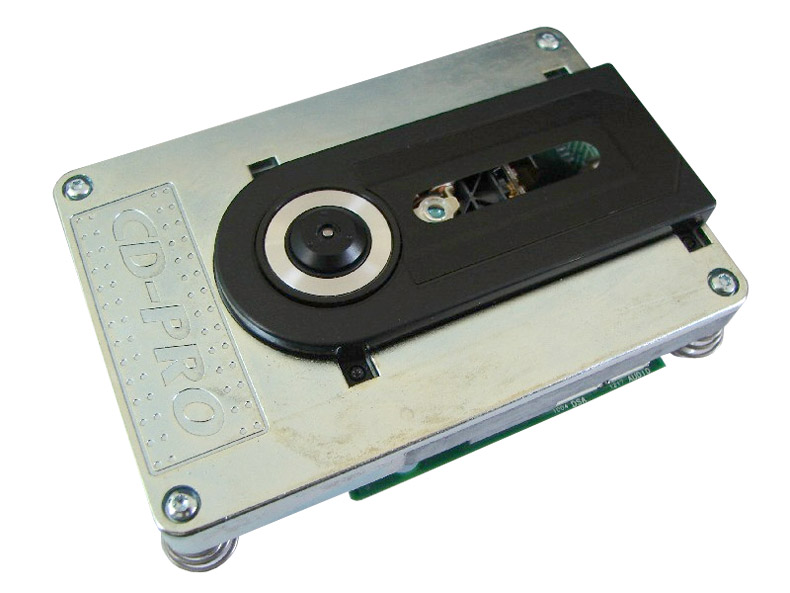Philips CDM12 / CD-Pro / CD-Pro2 / CD-ProM / CD-Pro2LF cdmechanism
Thanks to CD modules, designs of complete CD applications become very easy. Indeed, a module is made of a mechanism (optical pick-up unit) and a servo board (electronics). The CD mechanisms are exclusively designed for audio applications; hence an extremely low jitter level and excellent performances in audio data retrieving (focus and radial tracking). The servo board is also the fruit of Philips experience in optical data retrieving. As a consequence, the modules provide excellent playability for high-end audio applications, even with damaged discs (black dots, fingerprints, ...)
The modules include dedicated processors too. The firmware handles the required decoding, and communicates with the user section via a high-level interface (DSA) . Hence, development of customized applications is really easy.
The CDM12 Industrial was actually the first generation of professional modules to include a heavy die-cast metal frame. It rapidly met a big success in the audio/video industry. Indeed, the CDM12 Industrial module had a very successful life, particularly in two specialized markets : in the high-end audio market, because of its excellent ability to retrieve digital audio data and because its very good sound quality; in the jukebox market too, because of its robustness and reliability.
The CD-Pro and CD-Pro2 correspond to the next generations in terms of electronics. They are of course pin-to-pin compatible with the CDM12 Industrial. The main difference lies in the type of decoding device which is used in the application : the CDM12 Industrial (Premium 6000) includes the decoding chip SAA7345 (CD6) and the digital servo chip OQ8868 (DSICS). They are both replaced by the single chip SAA7372 (CD7) in the CD-Pro application (Premium 7000) and by the SAA7324 (CD10) in the CD-Pro2 application (Premium10501). The CD7 and CD10 show better performances, especially thanks to their improved error correction systems. Experience has also underlined that CD7 and CD10 are less sensitive to ESD.
Other changes brought to the CD-Pro and CD-Pro2 modules are the modification of the HF front end filter for improved playability with out-of-specification discs, or the implementation of a single gear ratio for the sledge movement instead of the previous 3/1 ratio, in order to bring stable sledge movements.
Then comes the CD-Pro2M. Actually, this module is more an upgrade of the CD-Pro2 than a new design in this range of products.
The main modification is the replacement of the laser unit, which has resulted in changing the flex assembly and the mounting frame as well. Of course, the new light pen can still read CD-DA, CD-R and CD-RW recorded audio discs.
The TDA1305 D/A Converter, which was used with all previous modules, has been replaced in the CD-Pro2M by a new generation 24-bit 192kHz DAC : the AK4384 chip from AKM.
The last modification is the improvement of the CD-Pro2M's firmware as regard to playability : the CD-Pro2M will play back standard CD-DA discs with an excellent playability, but it will read copy-protected discs as well, whatever the protection system which has been implemented.
The CD-Pro2LF has recently showed up, because of the RoHS directive introduced on the 1st of July, 2006. This directive concerns the restriction of hazardous substances in all electronic products sold in the European community, as well as in several other countries worldwide. The module has been modified to comply with this directive, and has consequently been renamed CD-Pro2LF (LF stands for "Lead Free").
The CD-Pro2LF includes all improvements brought with the CD-Pro2M module, and it continues to offer an excellent reliability and an unmatched playability (including with copy-protected discs), in accordance with the reputation of the CD-Pro family in the high-end and professional markets.
Still, the CD-Pro2LF remains 100% compatible, electrically and mechanically, with its predecessors (CD-Pro2M, CD-Pro2, CD-Pro and CDM12 Industrial). In other words, one should be able to replace a CDM12 Industrial module by a CD-Pro2LF in its existing application without any problem.
Grounding strategy has however changed since the CDM12 Industrial. The analogue and digital grounds were connected internally in the CDM12 Industrial Module. They are not connected anymore in its successors for obvious sound quality improvements. In order to optimize the performances of a CD application based on the CD-Pro, CD-Pro2, CD-Pro2M and CD-Pro2LF modules, both grounds have consequently to be connected on the user control board, in a strategic middle ground point.
Finally, all these modules are based on the standard DSA interface, and the same user software can consequently be used with any of them.
